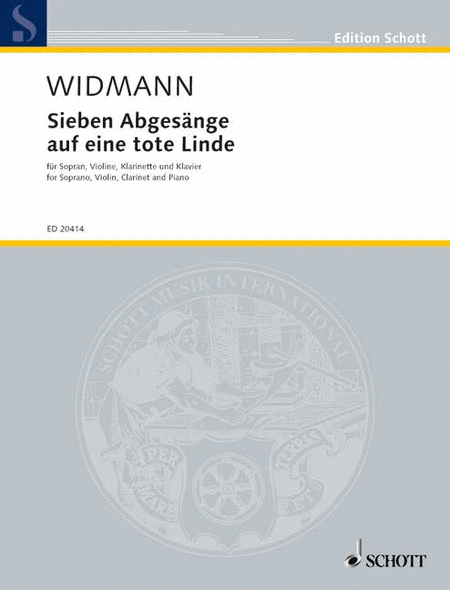Soprano, clarinet (in A and B), violin and piano - Digital Download SKU: S9.Q6718 On poems by Diana Kempff. Composed by Joerg Widmann. This edition: score and parts. Downloadable, Score and parts. Duration 18 minutes. Schott Music - Digital #Q6718. Published by Schott Music - Digital (S9.Q6718). German.Es war 1996, als mir Christoph Poppen, der damalige Leiter des Münchener Kammerorchesters, von einem kuriosen Konzert in Münsing (Ammerland) erzählte: während eines seiner Konzerte mit dem Orchester in der dortigen Kirche gab es, für alle hör- und sichtbar, eines der größten Unwetter, das die Region je gesehen hatte. Dabei schlug der Blitz ein in eine Art Wahrzeichen des Ortes, eine mehrere Jahrhunderte alte Linde. Unter den Zuhörern damals: die dort lebende Dichterin und Schriftstellerin Diana Kempff. Sie war unmittelbar erschüttert vom Tod der Linde und schrieb unter diesem Eindruck einige Gedichte. Christoph Poppen wiederum war – wie in vielen anderen Zusammenhängen auch – genialer Vermittler und stellte alsbald den Kontakt zu mir her. Die Idee: am Ort des Geschehens, in der Münsinger Kirche, solle ein Jahr später die Uraufführung einer Art Requiem für diesen Baum, der so vieles „gesehen“ hatte, erklingen. Im Rahmen der Holzhauser Musiktagen mit den Texten von Diana Kempff und meiner (noch zu schreibenden) Musik. Es gab bald eine wunderbare, sehr intensive Begegnung von Diana Kempff und mir, bei der sie etwas für Schriftsteller nicht gerade Typisches tat: sie stellte mir frei, aus den vorliegenden Gedichten nach Belieben lediglich Teile, sogar nur Zeilenfragmente zu verwenden und auch die Reihenfolge nach meinen Bedürfnissen anzuordnen und zu gestalten. Sie begriff sofort (und wünschte!), dass durch die Musik ohnehin etwas Drittes, etwas ganz Anderes entstehen würde. Die Tatsache, dass wir Monate später eine sichtlich bewegte Diana Kempff auf die Bühne holen durfte, freute uns alle besonders. Ihre Lyrik ist Ausdruck einer offenkundig zutiefst gequälten Seele und kommt uns oft wunderlich-versponnen entgegen. Einer zerbrechlichen Zartheit steht eine bisweilen fast brutale Härte unversöhnlich gegenüber. Das Schubert’sche „Fremd bin ich eingezogen“ gilt für sie in besonderer Weise und äußert sich in ihren Versen in einer Nähe zu allem Fremden (trotz des gleichzeitigen manischen Umkreisens des Eigenen und der eigenen Erinnerung), Abseitigen und auch (bei aller gleichzeitigen Skepsis) Übernatürlichen. Dieses geisterhaft-spukige Element versuchte ich durch meine Textauswahl und mit musikalischen Mitteln in diesen nun „Sieben Abgesängen“ zu verdeutlichen. Das erste Stück ist eine karge Studie über das Verrinnen der Zeit, das Nichts; das Zweite beschwört den Regen (den heilbringenden) herbei, der dann später – wenngleich mit entsetzlicher Wirkung – auch kommt. Den dritten Abgesang habe ich „Tanz der toten Seelen“ betitelt; es ist ein Zwiefacher, der jedoch durch seine düster-halbseidene „Wiener“ Chromatik alles Liebenswürdig-Oberbayerische längst verloren hat. Das klanglich vielleicht avancierteste und dichteste Stück ist der vierte Abgesang, der ganz aus der Perspektive der Linde selbst erzählt wird. Der fünfte Abgesang zu den Worten „Und wenn der Tod so kommen mag“ ist im Stile einer traurigen Volksweise bewusst schlicht gehalten. Während der sechste Satz in seinem expressionistischen Gestus nicht ungefährlich das Monodram streift, ist es schließlich die Seele (die ausgehauchte, die weiterexistierende?), die wörtlich den letzten Abgesang über die Bäume und die Seelen prägt. Diana Kempffs Gedichte, der Enthusiasmus Christoph Poppens, die phantastischen Uraufführungs-Interpreten, allen voran die Sängerin Juliane Banse, haben mich zur Komposition dieser „Sieben Abgesänge auf eine tote Linde“ angeregt. Die „Sieben Abgesänge“ sind nunmehr auch eine Erinnerung an die erst jüngst verstorbene Diana Kempff. Jörg Widmann, im Juni 2008.
